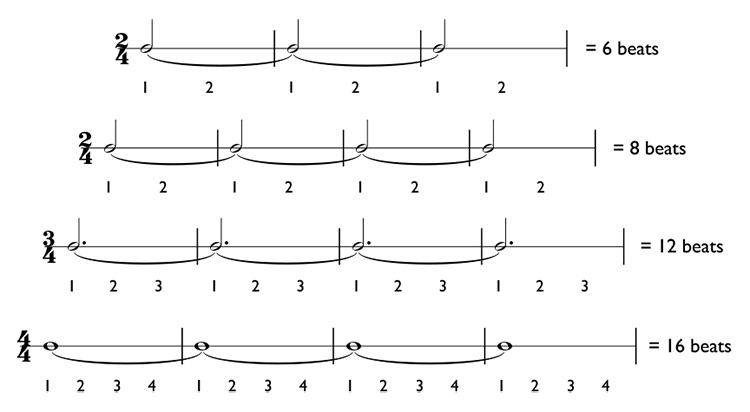Home - Fundamentals of Rhythm Table of Contents
Lesson 3: Ties Over Measure Lines and Syncopation
What do you do if you are composing a melody or a rhythm in 2/4 time, but you want to write a note that is four beats long? Since there are only two beats in a measure, you cannot use a whole note. The answer is to use ties.
Ties Over Measure Lines
Remember from Lesson 2 that the tie tells us to sustain or hold out the notes connected by the tie. Longer notes can be created by writing ties over measure lines.

Here are some more examples of tied notes and how long they are sustained when the quarter note is equal to one beat.

When we are clapping and counting rhythms, the numbers we speak represent the repeating beats in every measure. Even though four half notes tied together in 2/4 are held for eight beats, we do not count “one-two-three-four-five-six-seven-eight.” We count “one-two one-two one-two one-two.” In other words, rhythm patterns with ties are counted as if the ties were not there.
Syncopation
Many of the patterns in this lesson of The Fundamentals of Rhythm represent an important rhythmic device: syncopation. Syncopation occurs when emphasis is placed on a weak beat or unexpected beat. It is a device used to create rhythmic tension. To understand syncopation, we should review our introduction to meter. Remember that meter is created by repeating patterns of strong and weak beats.
In 2/4 time, beat one is stronger than beat two.
In 3/4 time, beat one is stronger than beats two and three.
In 4/4 time, beats one and three are stronger than beats two and four.
One way to create a syncopated rhythm is to place a rest on a strong beat and follow it with a note on a weaker beat. Technically speaking, some of the rhythms in Lessons 1 and 2 include syncopations. Pattern 106 is a good example of a basic syncopated rhythm. The syncopation is created by placing rests on beat one followed by notes on beat two in each measure.
Another way to create a syncopated rhythm is to write a tie over a measure line, and follow that tie with a note on a weak beat.
In the example below, all of the notes are syncopated.

Learn eighth notes and eighth rests in Lesson 4.
Write your own rhythms and music compositions! Get free blank staff paper at www.music-paper.com.







Get the Book
Fundamentals of Rhythm book
If you would like all of this information in book format so that you can put it on your music stand and practice it wherever you go, get The Fundamentals of Rhythm, by Kyle Coughlin. The book includes all of the lesson information and practice exercises found on the website.
Use MetronomeBot for a fun online metronome!
The online metronome that counts the beat, subdivides, and offers encouraging practice tips.
If you like this site, please share it with others!


Like Kyle Coughlin Music on Facebook
Follow Kyle Coughlin Music on Twitter